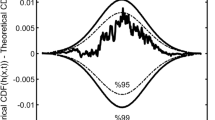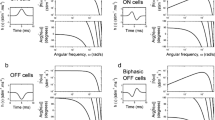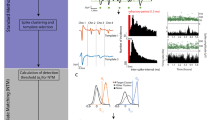Abstract
We present a spike-triggered averaging method capable of mapping the visual receptive fields of several neurons simultaneously. The stimulation is general and the mapping proceeds automatically without the need to match the stimulation to the cells' preference for position, orientation, direction, etc. The maps are spatiotemporal; receptive field (RF) structures are quantitatively determined in three dimensions: the two dimensions of visuotopic space, and time. The method presented is one of a family of “reverse correlation” or “spike-triggered averaging” techniques (DeBoer and Kuyper 1968) capable of revealing linear aspects of stimulus-response coupling. The formal relationship of these methods to stimulus-response crosscorrelation is shown. The analysis is extended to provide some second-order axis-of-motion information (“direction marks”). The stimulus is a constantly illuminated, randomly jumping bright or dark spot, not an elongated bar. Spot diameters between one-third to 1 × RF width are effective. The method ascertains for each recorded action potential or “spike” the prior visual field position of the spot. The average or most probable spot positions define the receptive field spatially. Repeating the process for a succession of times prior to observed spikes defines the field temporally, presented here as a succession of spatial maps. We term this portrayal a receptive field cinematogram, RFc or ciné. The RFc reveals and economically portrays the spread of excitability and suppression across the receptive field, culminating in the generation of a spike. RFcs for LGN neurons and for simple cells recorded in cat cortical areas 17 and 18 are presented and interpreted in terms of classic ON/OFF regions. The availability of temporal information permits the separation of an excitatory exit response, generated when a moving bright spot leaves an OFF region, from an excitatory entrance response occurring when a bright spot enters an ON region, because these responses occur at different times (exit responses earlier). Spike emission remains coupled to (cross-correlated with) stimulus events over time periods as long as 96 ms, implying that some stimulus drive or afferent visual input is delayed by as much as 96 ms more than other input. This is a striking instance of temporal dispersion in the visual system. In some cells, said to be “spatiotemporally inseparable”, the delay (latency) varies systematically across the visual field; i.e., the place for optimal stimulation varies with the time prior to spike emission. In these cells, the RFc shows receptive field structures which move across the visual field over trajectories equal to approximately twice the total conventional RF width. Exit and entrance responses, on the other hand, arise in a simple way from separated ON and OFF RF subregions. ON/ OFF mechanisms thus appear unrelated to spatiotemporal inseparability. The RFc method is easily automated, efficient, and characterizes multiple RFs simultaneously, as required in work with multiple electrode arrays.
Similar content being viewed by others
References
Aertsen AMHJ, Gerstein GL (1985) Evaluation of neuronal connectivity: sensitivity of cross-correlation. Brain Res 340:341–354
Aertsen AMHJ, Johannesma PIM (1981) A comparison of the spectro-temporal sensitivity of auditory neurons to tonal and natural stimuli. Biol Cybern 42:145–156
Aertsen AM, Gerstein GL, Habib MK (1989) Dynamics of neuronal firing correlation: modulation of “effective connectivity”. J Neurophysiol 61:900–917
Allman JM, Miezin FM, McGuinness E (1985) Stimulus specific responses from beyond the classical receptive field: neurophysiological mechanisms for local-global comparisons in visual neurons. Annu Rev Neuroscience 8:407–430
Barlow HB (1953) Summation and inhibition in the frog's retina. J Physiol (Lond) 119:69–88
Bishop PO, Coombs JS, Henry GH (1971) Responses to visual contours: spatio-temporal aspects of excitation in the receptive fields of simple striate neurons. J Physiol (Lond) 219:625–657
Bryant HL, Segundo JP (1976) Spike initiation by transmembrane currents: a white-noise analysis. J Physiol (Lond) 260:279–314
Camarda RM, Peterhans E, Bishop PO (1985a) Spatial organization of subregions in receptive fields of simple cells in cat striate cortex as revealed by stationary flashing bars and moving edges. Exp Brain Res 60:136–150
Camarda RM, Peterhans E, Bishop PO (1985b) Simple cells in cat striate cortex: Responses to stationary flashing and moving light bars. Exp Brain Res 60:151–158
DeAngelis GC, Ohzawa I, Freeman RD (1991) The spatiotemporal structure of RFs in the striate cortex: a comparison of kittens and cats. Invest Ophthal Vis Sci 32:1253
DeBoer E, Kuyper P (1968) Triggered correlation. IEEE Biomed Eng 15:169–179
Dinse HR, Krüger K, Best J (1990) A temporal structure of cortical information processing. Conc Neurosci 1:199–238
Duysens J, Orban GA, Glas H van der, Maes H (1982) Receptive field structure of Area 19 as compared to Area 17 of the cat. Brain Res 231:293–308
Eckhorn R, Pöpel B (1979) Generation of Gaussian noise with improved quasi-white properties. Biol Cybern 32:243–248
Eckhorn R, Habbel C, Krause F, Lohmann H, Reitboeck HJ, Schneider J (1984) Multi unit recordings from the visual system require special concepts. Neurosci Lett Suppl 18:S164
Eckhorn R, Krause F, Nelson JI (1986) The receptive field cinematogram: a multiple receptive field mapping technique for multiple microelectrode studies. Soc Neurosci 12:127
Eggermont JJ (1990) The correlative brain: theory and experiment in neural interaction. Springer, Berlin Heidelberg New York, pp 307
Emerson RC, Citron MC, Vaughn WJ, Klein SA (1987) Nonlinear directionally selective subunits in complex cells of cat striate cortex. J Neurophysiol 58:33–65
Fernald R, Chase, R (1971) An improved method for plotting retinal landmarks and focusing the eyes. Vision Res 11:95–96
Freeman RD, Ohzawa I (1990) On the neurophysiological organization of binocular vision. Vision Res 30:1661–1676
Habbel, C (1981) Entwurf und Bau eines optischen Mustergenerators fuer die Analyse von Schaltkreisen des visuellen Cortex bei simultaner Einzelzell-Registrierung vieler Neurone. (Design and construction of an optical pattern generator for the analysis of visual cortical circuitry through simultaneous recording of multiple neurons). Diplomarbeit/Master's Thesis, Fachbereich Physik, Philipps Universität, Marburg, Germany
Habbel, C (1985) Anpassung von Bildsignalen an die Übertragungseigenschaften von visuellen rezeptiven Einheiten. (The matching of picture signals to the transfer properties of visual receptive units). Dissertation, Fachbereich Physik, Philipps Universität, Marburg, Germany
Habbel C, Eckhorn R (1985) Automatic search for effective stimuli for units of the cat's visual cortex. Neurosci Lett Suppl 22:S302
Harth E, Tzanakou E (1974) ALOPEX: A stochastic method for determining visual receptive fields. Vision Res 14:1475–1482
Hartline HK (1938) The response of single optic nerve fibers of the vertebrate eye to illumination of the retina. Am J Physiol 121:400–415
Henry GH (1977) Receptive field classes of cells in the striate cortex of the cat. Brain Res 133:1–28
Henry GH, Lund JS, Harvey AR (1978) Cells of the striate cortex projecting to the Clare-Bishop area of the cat. Brain Res 151:154–158
Hida E, Naka K-I (1982) Spatio-temporal visual receptive fields as revealed by spatio-temporal random noise. Z Naturforsch 37c:1048–1049
Hida E, Naka K-I, Yokoyama K (1983) A new method for mapping spatio-temporal receptive field using television snow stimulation. J Neurosci Methods 8:225–230
Hubel DH, Wiesel TN (1962) Receptive fields, binocular interaction and functional architecture in the cat's visual cortex. J Physiol (Lond) 160:106–154
Johannesma PIM (1972) The pre-response stimulus ensemble of neurons in the cochlear nucleus. In: Cardozo BL (eds) Proceedings of the IPO Symposium on Hearing Theory. Eindhoven The Netherlands pp 58–69
Jones JP, Palmer LA (1987) The two-dimensional spatial structure of simple receptive fields in cat striate cortex. J Neurophysiol 58:1187–1211
Krause F (1981) Analyse der Bewegungsempfindlichkeit visueller kortikaler Neurone der Katze. (Analysis of the motion sensitivity of visual cortical neurons in the cat). Diplomarbeit/Master's thesis, Fachbereich Physik, Philipps Universität, Marburg, Germany
Krause F, Eckhorn R (1983) Receptive fields for motion stimuli (RFM) determined for different types of cat visual neurons. Neurosci Lett Suppl 14:209
Krause F, Eckhorn R, Habbel C (1984) Two types of direction selective mechanisms in simple units revealed by receptive field cinematograms. Pfluegers Arch 402:R51
Krause F, Gonzalez F, Nelson JI, Eckhorn R (1987) A fast method for predicting coding properties of visual cortical simple cells. Perception 16:269
Krause F, Nelson JI, Gonzalez P, Eckhorn R (1992) The receptive field cinematogram: comparison with conventional measures and application to direction selectivity
Kuffler SW (1953) Discharge patterns and functional organization of mammalian retina. J Neurophysiol 16:37–68
Lee YW, Schetzen M (1965) Measurement of the Wiener kernels of a nonlinear system by cross correlation. Int J Control 2:237–254
Lohmann H, Eckhorn R, Reitboeck HJ (1988) Visual receptive fields of local intracortical potentials. J Neurosci Methods 25:29–44
Mancini M, Madden BC, Emerson RC (1990) White noise analysis of temporal properties in simple receptive fields of cat cortex. Biol Cybern 63:209–219
Marmarelis PZ, Naka K-I (1973) Nonlinear analysis and synthesis of receptive field responses in catfish retina. I: Horizontal cell-ganglion cell chain. J Neurophysiol 36:605–618
McLean J, Palmer LA (1989) Contribution of linear spatiotemporal receptive field structure to velocity selectivity of simple cells in Area 17 of cat. Vision Res 29:675–679
Molenaar J, Voorhorst R, Schreurs AW, Broikhuyzen P, Nivard J, Grind WA van de (1980) A mechanical oscilloscope for vision research. Eur J Physiol 383:173–179
Naka K-I, Sakai HM (1991) The messages in optic nerve fibers and their interpretation. Brain Res Rev 16:135–149
Nelson JI, Frost BJ (1978) Orientation-selective inhibition from beyond the classic visual receptive field. Brain Res 139:359–365
Nelson JI, Frost BJ (1985) Intracortical facilitation among co-oriented co-axially aligned simple cells in cat striate cortex. Exp Brain Res 61:54–61
Nelson JI, Bullier J, Salin PA, Munk M H-J (1990) Three kinds of functional coupling between cat areas A17 and A18 revealed by cross-correlation. Soc Neurosci Abstr 16:1136
Nelson JI, Gonzalez F, Krause F (1992) The receptive field cinematogram: temporal dispersion in real and simulated visual neurons
Nelson JI, Salin PA, Munk MH-J, Arzi M, Bullier J (1992) Spatial and temporal coherence in cortico-cortical connections: a cross-correlation study in Areas 17 and 18 in the cat. Visual Neurosci 9:21–37
Nelson SB (1991) Temporal interactions in the cat visual system. I. Orientation-selective suppression in the visual cortex. J Neurosci 11:344–356
Orban GA, Kennedy H (1981) The influence of eccentricity on receptive field types and orientation selectivity in areas 17 and 18 of the cat. Brain Res 208:203–208
Reitboeck HJ (1983a) A 19-channel matrix drive with individually controllable fiber microelectrodes for neurophysiological applications. IEEE Trans Systems Man Cybern SMC 13:676–683
Reitboeck HJ (1983b) Fiber microelectrodes for electrophysiological recordings. J Neurosci Methods 8:249–262
Reitboeck HJ, Werner G (1983) Multi-electrode recording system for the study of spatio-temporal activity patterns of neurons in the central nervous system. Experientia 39:339–341
Reitboeck HJ, Adamczak W, Eckhorn R, Muth P, Thielmann R, Thomas U (1981) Multiple single-unit recording: Design and test of a 19-channel micromanipulator and appropriate fiber-electrodes. Neurosci Lett 7[Suppl]:148
Rodieck RW, Stone J (1965a) Response of cat retinal ganglion cells to moving visual patterns. J Neurophysiol 28:819–832
Rodieck RW, Stone J (1965b) Analysis of receptive fields of cat retinal ganglion cells. J Neurophysiol 28:833–849
Shingai R, Hida E, Naka K-I (1983) A comparison of spatio-temporal receptive fields of ganglion cells in the retinas of the tadpole and adult frog. Vision Res 23:943–950
Spinelli DN, Barrett TW (1969) Visual receptive field organization of single units in the cat's visual cortex. Exp Neurol 24:76–98
Stevens JK, Gerstein GL (1976) Spatiotemporal organization of cat lateral geniculate receptive fields. J Neurophysiol 39:213–238
Sutter EE (1974) Electrophysiological investigation of visual units in the cat: a revised conception of receptive fields. Soc Neurosci Abstr 4:444
Victor JD, Shapley RM, Knight, BW (1977) Nonlinear analysis of cat retinal ganglion cells in the frequency domain. Proc Natl Acad Sci USA 74:3068–3072
Wiener N (1958) Nonlinear problems in random theory. Wiley, New York
Author information
Authors and Affiliations
Rights and permissions
About this article
Cite this article
Eckhorn, R., Krause, F. & Nelson, J.I. The RF-cinematogram. Biol. Cybern. 69, 37–55 (1993). https://doi.org/10.1007/BF00201407
Received:
Accepted:
Issue Date:
DOI: https://doi.org/10.1007/BF00201407




